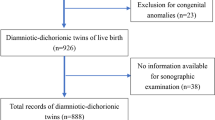Abstract
Abnormal growth in one or both twins may contribute to the increased morbidity and mortality observed in twin gestation. Our objective in this retrospective study of all twin pregnancies delivered at our hospital (n = 240) over a 2-year period was to study the relationship between placental lesions and abnormal growth. Standardized placental examinations were performed in 192 cases (80%), which constituted the study population. Two growth abnormalities were studied: discordant growth as defined by >15% difference in birth weight and small-for-gestational-age (SGA) birth as defined by birth weight less-than the 10th percentile for gestational age. The majority of twin pregnancies with either discordant growth (41/57 cases) or SGA birth (26/35 cases) had dichorionic placentas. In monochorionic placentas studied by injection there was no significant relationship between vascular anastomoses and discordant growth. Placental weight for small discordant and SGA twins was equivalent or increased relative to infant weight, a pattern not suggestive of maternal vascular underperfusion. Eight lesions, five considered to represent chronic placental disease and three considered to represent intrauterine adaptation, were studied as possible predictors of abnormal growth. The overall prevalence of these lesions in twin placentas was less than that seen in singleton births. Concordance between twin placentas for most lesions was higher than would be expected, based on their prevalence in singleton placentas. Two lesions were associated with discordant growth in both univariate and multivariate analyses: peripheral cord insertion (OR 3.6, 95% CI 1.7–7.6) and avascular villi (AV; OR 3.2, 95% CI 1.0–10.3). Three placental lesions were associated with SGA infants at the univariate level: peripheral cord insertion, avascular villi, and maternal vascular underperfusion. Only peripheral cord insertion (OR 9.8, 95% CI 4.1–23.4) and AV (OR 3.7, CI 1.0–13.7) were significant in the multivariate analysis. The relative increase in peripheral cord insertion and AV with abnormal growth was observed for both monochorionic and dichorionic placentas. Subgroups of discordant infants with and without SGA were both associated with peripheral cord insertion while only those with SGA had an increase in AV. Both peripheral cord insertion and AV were increased in the subgroup with SGA but no discordancy. In summary, two placental lesions, peripheral cord insertion indicating a spatially limited intrauterine compartment and AV indicating occlusion of fetal vessels in the placenta, were associated with abnormal growth in twins.
Similar content being viewed by others
Author information
Authors and Affiliations
Additional information
Received November 20, 2000; accepted April 2, 2001.
Rights and permissions
About this article
Cite this article
Redline, R., Shah, D., Sakar, H. et al. Placental Lesions Associated with Abnormal Growth in Twins. Pediatr. Dev. Pathol. 4, 473–481 (2001). https://doi.org/10.1007/s10024001-0044-z
Published:
Issue Date:
DOI: https://doi.org/10.1007/s10024001-0044-z




